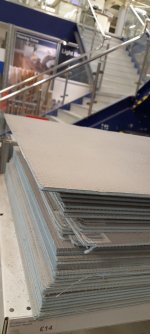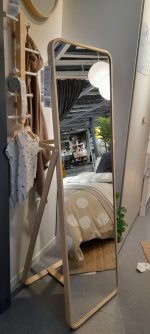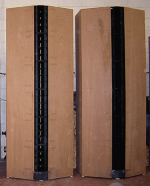It is considered as a standard that a speaker should face directly at you, or that we look at the speaker to get the best sound out of it. But our ears hear sounds from every direction, maybe somewhat less from the back. A few years ago, I placed the shop-bought speakers upfiring, the speaker plane ~90cms above floor. My ears are ~113cm above floor where I usually sit at the desk. From the armchair, ears are below 90cm. It's 180cm to the ceiling from the speaker plane. But I hear the music better, much better than speakers facing me. The room appears to be engulfed in sound. I've checked this with 3 pairs of speakers from different manufacturers. If I place these speakers facing me, it feels like I'm losing some quality. So, after a while they go upfiring. Plastered brick walls, parquet floor, 70-plus-year-old flat.
Those, who have DMLs, please consider placing them horizontally and check the sound quality, subjective of course. Just for fun. 🙂
Thank you
Those, who have DMLs, please consider placing them horizontally and check the sound quality, subjective of course. Just for fun. 🙂
Thank you
Eric.
This is an interesting patent from Paul Burton.
He talks about exciter design and damping of a thin film panel.
I'm not sure if this is the design NXT spent millions on ,but it does sound similar?
Figs 9,10,11, seem to have disappeared.
Steve.
Oops forgot to put in the link.
https://patents.google.com/patent/US4924504A/en
This is an interesting patent from Paul Burton.
He talks about exciter design and damping of a thin film panel.
I'm not sure if this is the design NXT spent millions on ,but it does sound similar?
Figs 9,10,11, seem to have disappeared.
Steve.
Oops forgot to put in the link.
https://patents.google.com/patent/US4924504A/en
Chdsl.
Many years ago I used up firing cone drive units similar to G A Briggs design.
While for orchestral music the reflections from the walls and ceiling sounded very realistic, amazing in fact.
The downside was playing studio recorded music.
For instance, my favourite electric guitar solos sounded as if they were playing a couple of rooms away 😱
I got around this mostly by tilting the cone speaker forwards a little to give me some direct radiation.
My small card or veneer panels would suit this method well I think.
Maybe with a slight tilt still though?
Depending on walls and ceilings, you could end up with the reflections being louder than the direct sound.
I even had upwards and downward firing units at one stage, I think this was the straw that broke the camels back, and why I am now banned to the garage conversion 😫
Although now it has become my sanctuary 😁
If it works ,it works.
Steve.
Many years ago I used up firing cone drive units similar to G A Briggs design.
While for orchestral music the reflections from the walls and ceiling sounded very realistic, amazing in fact.
The downside was playing studio recorded music.
For instance, my favourite electric guitar solos sounded as if they were playing a couple of rooms away 😱
I got around this mostly by tilting the cone speaker forwards a little to give me some direct radiation.
My small card or veneer panels would suit this method well I think.
Maybe with a slight tilt still though?
Depending on walls and ceilings, you could end up with the reflections being louder than the direct sound.
I even had upwards and downward firing units at one stage, I think this was the straw that broke the camels back, and why I am now banned to the garage conversion 😫
Although now it has become my sanctuary 😁
If it works ,it works.
Steve.
I was looking through my photo album and came across these pics.
The first is a material in wickes I bought years ago, except this is a 5mm panel.
Mine was a 1cm panel and much more rigid.
This one feels more flexible and would be a better option, the 1cm panel had a very hard sound to it that I did not like.
The second pic is in Ikea, I'm always trying to get ideas for panel design, but without the glass mirror, although it would look good, especially with me in it 🤓
Steve.
The first is a material in wickes I bought years ago, except this is a 5mm panel.
Mine was a 1cm panel and much more rigid.
This one feels more flexible and would be a better option, the 1cm panel had a very hard sound to it that I did not like.
The second pic is in Ikea, I'm always trying to get ideas for panel design, but without the glass mirror, although it would look good, especially with me in it 🤓
Steve.
Attachments
I mentioned this long ago in this thread. Harold Beveridge had his speakers set up in his home to the sides of the listening area. Left and right of someone sitting in the center of the room facing the listener's ears.It is considered as a standard that a speaker should face directly at you, or that we look at the speaker to get the best sound out of it. But our ears hear sounds from every direction, maybe somewhat less from the back...
I spent an after hours evening at the old Stereo Exchange on Broadway in NY back in the 1970's where a group of us tried the same configuration.
Pretty amazing. At one point in the evening we set up a subwoofer in the center of the room, sat on it and listened to the Beverages. Even more amazing! (We also tried sitting of the sub woofer with Stax headphones).
Attachments
Thank you Burnt, Eric and Paul for your responses much appreciated.
There are several more questions coming once I full digest all the information.
There are several more questions coming once I full digest all the information.
You're welcome, fire away whenever you are ready.Thank you Burnt, Eric and Paul for your responses much appreciated.
There are several more questions coming once I full digest all the information.
Eric
Glad we don't have a garage conversion... 🙂 Wife is not always happy with my 'experiments' in the living room.Depending on walls and ceilings, you could end up with the reflections being louder than the direct sound.
I even had upwards and downward firing units at one stage, I think this was the straw that broke the camels back, and why I am now banned to the garage conversion 😫
Anyway, have you tried placing the transducer in an upside-down hat box?
Tagis you are very welcomeThank you Burnt, Eric and Paul for your responses much appreciated.
There are several more questions coming once I full digest all the information.
Burnt
Steve,Eric.
This is an interesting patent from Paul Burton.
He talks about exciter design and damping of a thin film panel.
I'm not sure if this is the design NXT spent millions on ,but it does sound similar?
Figs 9,10,11, seem to have disappeared.
Steve.
Oops forgot to put in the link.
https://patents.google.com/patent/US4924504A/en
Thanks I had not seen that one before. The missing figures are actually on "sheet 2" along with figs 2-5, for whatever reason. Saving paper I suppose.
I wonder if this damping mechanism was truly effective or not.
Eric
Eric.
Thanks, I was using my phone and was zooming in on figs 3,4,5 so did not spot figs 9,10,11.
Interesting how half the coil is on the panel surface 51 and not in the magnet gap .
Although they say it nr 61 ?
Steve.
Thanks, I was using my phone and was zooming in on figs 3,4,5 so did not spot figs 9,10,11.
Interesting how half the coil is on the panel surface 51 and not in the magnet gap .
Although they say it nr 61 ?
Steve.
No but I did have a cone driver in one of my wife's le creuset saucepans held up close to the ceiling with a broomstick.Glad we don't have a garage conversion... 🙂 Wife is not always happy with my 'experiments' in the living room.
Anyway, have you tried placing the transducer in an upside-down hat box?
Or was that the straw that broke the camels back🤣
Our front room looked very similar to my garage room now.😱
Steve.
OK, back to the topic. My wife says, when the transducer is touching the back of the 5mm thick EPS sheet, the music, voices coming out of it are quite clear, but it feels like everything is coming from a horn. She has a music school background and has a keen ear. The sound from the polystyrene sheet is nowhere near the sound from the boxed, bass reflex speakers. You've made so many DMLs, what's your subjective feeling?Steve.
I found myself scratching my head at some of the descriptions, particularly after the word 'therefore', where I could not reconcile the antecedent with the consequent. But the leading paragraph did resonate 🙂)) with some ruminations Ive had about the reported effectiveness of art canvas panels at low frequencies. AFAIK, a slow moving (wrt speed of sound in air), low frequency oscillation in a membrane should not give much of a response in the far field. Maybe there are specific phase effects at play, like a phased array of antennas, that give a focused signal at the listening position. Then again, in a small room at LF, the notion of far/near field is a bit fuzzy anyway.Steve,
Thanks I had not seen that one before. The missing figures are actually on "sheet 2" along with figs 2-5, for whatever reason. Saving paper I suppose.
I wonder if this damping mechanism was truly effective or not.
Eric
Last edited:
Pepe.
https://www.diyaudio.com/community/threads/wave-speakers-how-do-they-work.164414/page-3
I read through this forum on bending wave loudspeakers 😱 and came across you in a 2016 post.
LineArray talks about his bending wave panels, but I could not see any pictures or information about them ,did he show them somewhere else ?
Steve.
https://www.diyaudio.com/community/threads/wave-speakers-how-do-they-work.164414/page-3
I read through this forum on bending wave loudspeakers 😱 and came across you in a 2016 post.
LineArray talks about his bending wave panels, but I could not see any pictures or information about them ,did he show them somewhere else ?
Steve.
Chdsl.
You are touching the exciter onto the panel ?
This will not sound good, by the way, this is not a full range panel, so comparing with a boxed bass reflex speaker will sound very strange.
The skin of the EPS must be sanded off and replaced with a 50x50 mix of PVA and water .
The EPS skin has a strange sound to it, so I remove it.
You could listen to the sound with the skin sanded off, this produces a softer sound that some may like?
But still coat the area around the exciter by an inch or two to help support the exciter and aid sound transfer.
I still have a 6ft panel that I have not got around to coating yet, and ever time I use it it still sheds white power on the floor, so be warned.
Steve.
You are touching the exciter onto the panel ?
This will not sound good, by the way, this is not a full range panel, so comparing with a boxed bass reflex speaker will sound very strange.
The skin of the EPS must be sanded off and replaced with a 50x50 mix of PVA and water .
The EPS skin has a strange sound to it, so I remove it.
You could listen to the sound with the skin sanded off, this produces a softer sound that some may like?
But still coat the area around the exciter by an inch or two to help support the exciter and aid sound transfer.
I still have a 6ft panel that I have not got around to coating yet, and ever time I use it it still sheds white power on the floor, so be warned.
Steve.
Chdsl.
Do not sand too heavily, I just scuff the surface to make it soft and fluffy, this will soak up the PVA mix.
Do not worry about applying to much of the PVA mix as it is mainly water and will evaporate and create a hard surface.
Steve.
Do not sand too heavily, I just scuff the surface to make it soft and fluffy, this will soak up the PVA mix.
Do not worry about applying to much of the PVA mix as it is mainly water and will evaporate and create a hard surface.
Steve.
Yes, I know about the sanding and adding diluted PVA. EPS is expanded polystyrene balls fixed to each other by heat and high pressure through surface tension in a pressure chamber. Once cut to slabs, these expanded polystyrene balls get cut, but not exactly at the middle. EPS has air bubbles stuck within it, so the horn like sound. With the PVA, you simply block the entrances that happened after cutting. Depending on how much PVA you add to one plane or to all 6 planes of the EPS sheet, the resulting sound changes. In the XPS sheet, as it is moulded, the pores are closed. Had been playing with both types, but still can't decide, which is better. 🙂Chdsl.
Do not sand too heavily, I just scuff the surface to make it soft and fluffy, this will soak up the PVA mix.
Do not worry about applying to much of the PVA mix as it is mainly water and will evaporate and create a hard surface.
Steve.
- Home
- Loudspeakers
- Full Range
- A Study of DMLs as a Full Range Speaker


